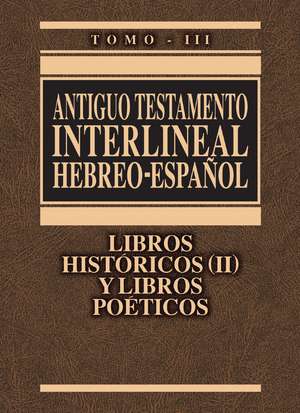Antiguo Testamento interlineal Hebreo-Español Vol. 3: Libros históricos 2 y libros poéticos: Antiguo Testamento interlineal Hebreo-Espanol
Autor Zondervanes Limba Spaniolă Hardback – 9 feb 2009
Debajo de cada palabra hebrea viene la traducción literal. Se ha seguido un criterio literalista, de modo que aunque muchas expresiones y giros idiomáticos no tienen un sentido claro al verterse literalmente al castellano, sa ha preferido seguir este criterio a fin de acercar más al lector el texto original. Este tercer volumen contiene la segunda parte de los Libros Históricos y todos los Libros Poéticos.
Old Testament Interlinear Hebrew-Spanish Vol 3
This work of several volumes contains the entire text of the Old Testament in Hebrew characters in accordance with the original manuscript of Leningrad, which is though to be the most complete and most ancient of all the manuscripts known to be in existence at this time.
A literal translation of each Hebrew word appears directly underneath each word. A literalistic method was chosen because even though many of the expressions and idiomatic usages may not seem to have a clear meaning when translated directly into the Spanish, this approach was preferred in order to bring the reader closer to the original text.
Preț: 241.47 lei
Nou
Puncte Express: 362
Preț estimativ în valută:
46.21€ • 48.46$ • 38.47£
46.21€ • 48.46$ • 38.47£
Carte indisponibilă temporar
Doresc să fiu notificat când acest titlu va fi disponibil:
Se trimite...
Preluare comenzi: 021 569.72.76
Specificații
ISBN-13: 9788476459515
ISBN-10: 8476459513
Pagini: 896
Dimensiuni: 162 x 222 x 44 mm
Greutate: 1.23 kg
Editura: CLIE
Colecția CLIE
Seria Antiguo Testamento interlineal Hebreo-Espanol
Locul publicării:Grand Rapids, United States
ISBN-10: 8476459513
Pagini: 896
Dimensiuni: 162 x 222 x 44 mm
Greutate: 1.23 kg
Editura: CLIE
Colecția CLIE
Seria Antiguo Testamento interlineal Hebreo-Espanol
Locul publicării:Grand Rapids, United States
Descriere
Presentamos el tercer volumen de una obra que contiene todo el texto del Antiguo Testamento en caracteres hebreos según los originales del manuscrito de Leningrado, el más completo y más antiguo de los que se conocen hasta el día de hoy.
Debajo de cada palabra hebrea viene la traducción literal. Se ha seguido un criterio literalista, de modo que aunque muchas expresiones y giros idiomáticos no tienen un sentido claro al verterse literalmente al castellano, sa ha preferido seguir este criterio a fin de acercar más al lector el texto original. Este tercer volumen contiene la segunda parte de los Libros Históricos y todos los Libros Poéticos.
Old Testament Interlinear Hebrew-Spanish Vol 3
This work of several volumes contains the entire text of the Old Testament in Hebrew characters in accordance with the original manuscript of Leningrad, which is though to be the most complete and most ancient of all the manuscripts known to be in existence at this time.
A literal translation of each Hebrew word appears directly underneath each word. A literalistic method was chosen because even though many of the expressions and idiomatic usages may not seem to have a clear meaning when translated directly into the Spanish, this approach was preferred in order to bring the reader closer to the original text.
Debajo de cada palabra hebrea viene la traducción literal. Se ha seguido un criterio literalista, de modo que aunque muchas expresiones y giros idiomáticos no tienen un sentido claro al verterse literalmente al castellano, sa ha preferido seguir este criterio a fin de acercar más al lector el texto original. Este tercer volumen contiene la segunda parte de los Libros Históricos y todos los Libros Poéticos.
Old Testament Interlinear Hebrew-Spanish Vol 3
This work of several volumes contains the entire text of the Old Testament in Hebrew characters in accordance with the original manuscript of Leningrad, which is though to be the most complete and most ancient of all the manuscripts known to be in existence at this time.
A literal translation of each Hebrew word appears directly underneath each word. A literalistic method was chosen because even though many of the expressions and idiomatic usages may not seem to have a clear meaning when translated directly into the Spanish, this approach was preferred in order to bring the reader closer to the original text.

